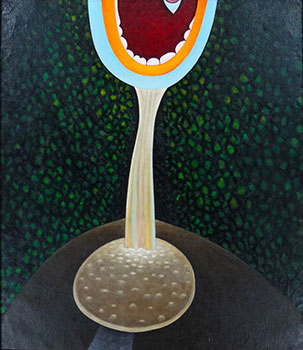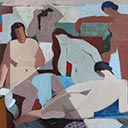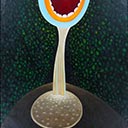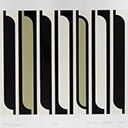Waterfall
68.5 x 59 cm
Michael Illingworth's Untitled depicts an abstracted landscape in which a mouth-like form and half an eye can be glimpsed at the top of a flowing organic structure. Like previous works, Untitled is much more closely aligned with nature than the grid-like structure of the city or suburbia. As Aaron Lister and Damian Skinner argue: In their celebration of the 'natural order', the anthropomorphic landscapes are closely connected to the Adam and Eve paintings. Adam and Eve are depicted in the landscape, not separated from it, and like these landscape paintings symbolise a now lost, natural order. (A Lister and D Skinner, A Tourist in Paradise Lost, p.27) Untitled is also characteristic of Illingworth's practice in the luminosity of colour that is achieved in the work. The effect is almost that of a stained-glass window, with light seeming to shine through the work, illuminating its gold sections and jewel-like, green speckled background
Illingworth painted and repainted each work for days and weeks at a time until he brought out its hidden depths, just as a jeweller, by working again and again at a stone's surfaces, manages almost magically to bring out a glowing and intense colour from its core. Mike worked by illumination from within. His best paintings, in every sense, have a mysterious inner life. He learnt this from no one. It is his personal mark. (Kevin Ireland, 'Michael Illingworth - Out of a Window and into a Garden' in Aaron Lister and Damien Skinner, A Tourist in Paradise Lost: The Art of Michael Illingworth, Wellington: City Gallery, 2001, p.10 -11.)
British born Michael Illingworth developed as a painter in New Zealand from the 1960s through to the 1980s. His first major solo show in New Zealand was at Ikon Gallery in 1963, after returning from several years in London. There, Illingworth had worked at Gallery One as an assistant to art dealer Victor Musgrave, forming friendships with several of the gallery's artists, and expanding his knowledge of international art. Illingworth's style and subject matter were unique within predominant painting practices in New Zealand at the time. Several elements can be seen within his painting that bear similarities to the work of artists such as Paul Klee and Joan Miro
Illingworth was one of the key artists at Ikon Gallery and later at Barry Lett Galleries. Today, he is perhaps best known for his figurative works: featuring the so-called 'Piss-Quicks' and Adam and Eve figures. Throughout much of his practice, Illingworth critiqued many aspects of bourgeois culture. He focused particularly on what he felt was the alienation of middle-class suburbia. In the late 1960s and 1970s however, and in works such as Untitled, he moved away from such explicit social critique





